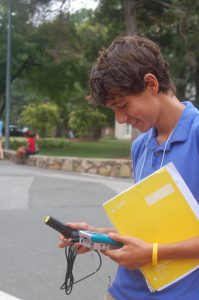COEC collaboration will engage youth and public health professionals on climate & health

Student uses sensor to investigate the concentration of carbon dioxide in the air
The Community Outreach and Engagement Core (COEC) in the UNC-Chapel Hill Center for Environmental Health and Susceptibility—together with COECs from the NIEHS Center for Environmental Health in Northern Manhattan at Columbia University and the Harvard-NIEHS Center for Environmental Health at Harvard University—received a $100,000 supplemental grant from NIEHS to foster climate literacy among high school students and health professionals.
This year-long project engages high school students from central North Carolina and New York City in intensive science education and leadership development focused on the potential health outcomes of a changing climate. Educational materials that are developed for the project, which will draw on NIEHS-funded research and will include hands-on activities, also will be adapted and extended to pediatric, pre-natal and public health professionals via online learning opportunities. In addition, the project will connect participating students and health professionals, to support students’ future career development.
This collaboration is further strengthened by the participation of three local partners, including: the Alliance for Climate Education in North Carolina; WE ACT for Environmental Justice (WE ACT) in New York; and Boston Children’s Hospital and the Region 1 New England Pediatric Environmental Health Specialty Unit (PEHSU) in Massachusetts. Working with these community partners enhances each COEC’s ability to offer locally relevant, place-based learning opportunities and prepares participants to engage in solving the public health challenges posed by climate change.
According to COEC Director Kathleen Gray, “We’re excited to be part of such a dynamic team, working to cultivate a network of youth and health professionals who are informed about the potential health effects of climate change and also are prepared to develop health-protective, community-based solutions.”
